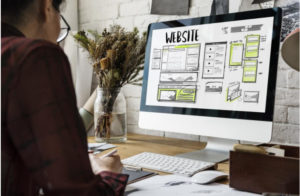 A user-friendly and successful experience is created by combining various features in modern website design. Typography, layout, color theory, grid systems, motion graphics, and responsive designs are a few. Website designers frequently concentrate on building sites that are aesthetically pleasing and simple to use.
A user-friendly and successful experience is created by combining various features in modern website design. Typography, layout, color theory, grid systems, motion graphics, and responsive designs are a few. Website designers frequently concentrate on building sites that are aesthetically pleasing and simple to use.
They want users to quickly and easily find what they’re looking for without going through several pages of content. Additionally, contemporary website designs ought to be flexible enough to alter as new gadgets or technologies are developed. Modern web design can be difficult, but you can use numerous tools and methods to get the desired result.
Utilizing flat design components like gradients and color palettes is one well-liked method.
Modern Design Trends
If you want your website to look its best, you should be aware of a few current web design trends. Some of the prominent trends are:
Full-Page Headers
Full-page headers are a tried-and-true design element. Since the early days of the internet, full-page headers have been incorporated into website designs to showcase specific pages of your website. In order to ensure brand consistency across multiple pages of your website and to ensure that visitors always know where they are going, a full-page header is also useful.
Visit now to accept Wix payouts in several cryptocurrencies of your choice.
Full-page headers have been used since websites first appeared, but this trend didn’t fully take off until the popularity of mobile devices. Full-page headers can assist in building branding consistency across several pages of your website and are increasingly useful for directing users to certain web pages.
Image Headers
Like full-page headers, image headers act as a focal point for the content on your website. However, image headers go a step further by including images in the header. This improves the visual appeal of your website’s header and detracts users from other aspects, like text content on the page.
Find a balance between utilizing too many photos and not enough text, as with any design choices, to avoid having a cluttered and unprofessional-looking website.
Grid Design
No matter what device people use to access your site, grids make it simple to give each page a consistent appearance. Regardless of the visitor’s screen size, site navigation is made simpler by building adaptable websites with flexible and expandable grids. The fundamental concept of a grid-based design is that all of your content is laid out within a preset set of rows and columns, and then CSS is used to specify how much space each element receives. You can center or align header graphics on the left or right.
White Space
White space may be added to your website in various methods, but the most frequent one is to enlarge your photographs and leave more space around them. Users are exposed to more of your material with this technique, which might be beneficial if you have a lot of text-heavy pages.
For instance, Airbnb keeps its text basic by surrounding it with additional white space and ensuring that all elements are unmistakably identified as buttons or links when hovered over.
Custom Illustrations
Illustrations are widely used in contemporary web design. They’re an excellent way to break up the material on your website and add visual interest to keep people interested and returning. Establishing business identification through expertly created custom graphics is another wonderful strategy.
Parallax Scrolling
Facebook and Twitter made parallax scrolling popular, becoming a crucial component of their designs. When the foreground image moves faster than the background image, depth is created through the parallax effect. This gives motion and depth appearance, making content more captivating for viewers.
Greater Focus on UX/UI
The visual design of a website has always been the main focus of the user experience. The ability to produce an efficient user experience is no longer sufficient. You should start focusing more on user interface and usability as well. Visitors are accustomed to interacting with websites in various ways, such as selecting the text, scrolling around pages, or clicking on buttons or links.
Designers don’t concentrate on making the site easier to use since they presume that users already understand how it operates. Instead, they concentrate on preventing a frustrating visit from happening. They frequently make things more difficult than they need to be, for instance, by default burying menus.
Catchy Anecdotes
Not only are stories good at capturing attention, but they also motivate visitors to engage with your website. This facilitates the generation of leads, engagement, and sales. It seems to sense that firms are seeking ways to include narrative into their websites and that this trend will continue in 2023.
Final Thoughts
Despite the advancements in online design, there is still something about a website that attracts more potential clients. Businesses may obtain a sleek and contemporary image with the correct web design, making them stand out from the competition. Embrace the vital elements to turn your website into a modern online space!


